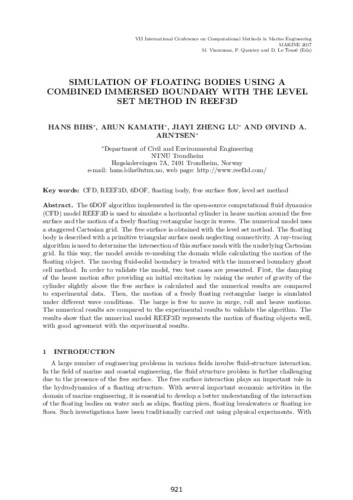Mostra el registre d'ítem simple
Simulation of floating bodies using a combined immersed boundary with the level set method in REEF3D
| dc.contributor.author | Bihs, Hans |
| dc.contributor.author | Kamath, Arun |
| dc.contributor.author | Lu, Jiayi Zheng |
| dc.contributor.author | Arntsen, Oivind A. |
| dc.date.accessioned | 2020-11-12T17:02:17Z |
| dc.date.available | 2020-11-12T17:02:17Z |
| dc.date.created | 2017 |
| dc.date.issued | 2017 |
| dc.identifier.citation | Bihs, H. [et al.]. Simulation of floating bodies using a combined immersed boundary with the level set method in REEF3D. A: MARINE VII. "MARINE VII : proceedings of the VII International Conference on Computational Methods in Marine Engineering". CIMNE, 2017, p. 921-931. ISBN 978-84-946909-8-3. |
| dc.identifier.isbn | 978-84-946909-8-3 |
| dc.identifier.uri | http://hdl.handle.net/2117/332091 |
| dc.description.abstract | The 6DOF algorithm implemented in the open-source computational fluid dynamics (CFD) model REEF3D is used to simulate a horizontal cylinder in heave motion around the free surface and the motion of a freely floating rectangular barge in waves. The numerical model uses a staggered Cartesian grid. The free surface is obtained with the level set method. The floating body is described with a primitive triangular surface mesh neglecting connectivity. A ray-tracing algorithm is used to determine the intersection of this surface mesh with the underlying Cartesian grid. In this way, the model avoids re-meshing the domain while calculating the motion of the floating object. The moving fluid-solid boundary is treated with the immersed boundary ghost cell method. In order to validate the model, two test cases are presented. First, the damping of the heave motion after providing an initial excitation by raising the center of gravity of the cylinder slightly above the free surface is calculated and the numerical results are compared to experimental data. Then, the motion of a freely floating rectangular barge is simulated under different wave conditions. The barge is free to move in surge, roll and heave motions. The numerical results are compared to the experimental results to validate the algorithm. The results show that the numerical model REEF3D represents the motion of floating objects well, with good agreement with the experimental results. |
| dc.format.extent | 11 p. |
| dc.language.iso | eng |
| dc.publisher | CIMNE |
| dc.rights | Open access |
| dc.subject | Àrees temàtiques de la UPC::Matemàtiques i estadística::Anàlisi numèrica::Mètodes en elements finits |
| dc.subject.lcsh | Finite element method |
| dc.subject.lcsh | Marine engineering |
| dc.subject.other | CFD, REEF3D, 6DOF, floating body, free surface flow, level set method |
| dc.title | Simulation of floating bodies using a combined immersed boundary with the level set method in REEF3D |
| dc.type | Conference report |
| dc.subject.lemac | Enginyeria naval |
| dc.rights.access | Open Access |
| local.citation.contributor | MARINE VII |
| local.citation.publicationName | MARINE VII : proceedings of the VII International Conference on Computational Methods in Marine Engineering |
| local.citation.startingPage | 921 |
| local.citation.endingPage | 931 |


